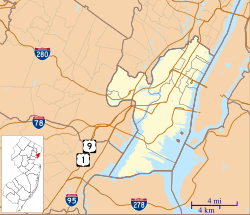Old Bergen Church | |
 Old Bergen Church in 2020 | |
| Location | Bergen and Highland Avenue, Jersey City, New Jersey |
|---|---|
| Coordinates | 40°43′37″N74°4′10″W / 40.72694°N 74.06944°W |
| Area | 0.5 acres (0.20 ha) |
| Built | 1841 |
| Architect | William H. Kirk and Company, Clark and Van Nest |
| Architectural style | Greek Revival |
| NRHP reference No. | 73001103 [1] |
| NJRHP No. | 1520 [2] |
| Significant dates | |
| Added to NRHP | August 14, 1973 |
| Designated NJRHP | June 13, 1973 |
The Old Bergen Church is a historic church congregation in Jersey City, Hudson County, New Jersey, United States. Established in 1660 in what was then the Dutch colony of New Netherland, it is the oldest continuous religious congregation in what is today the State of New Jersey. The congregation is jointly affiliated with the Reformed Church in America and the Presbyterian Church (USA). [3] The church was added to the National Register of Historic Places on August 14, 1973. The original church building was constructed in 1680 and the current edifice was built in 1841. [4]




